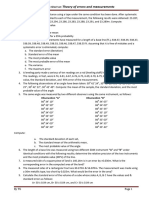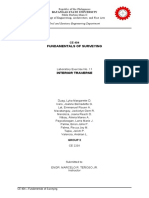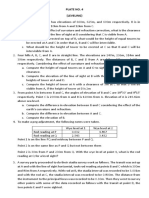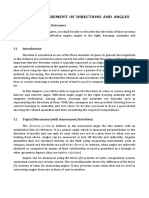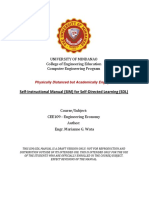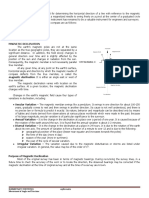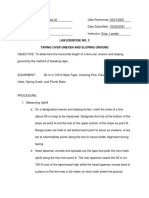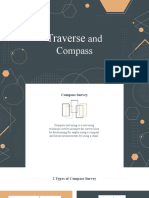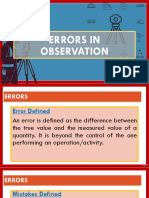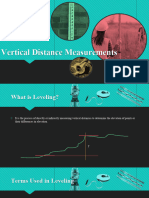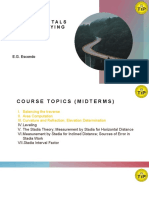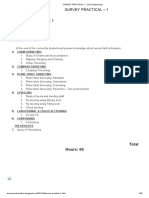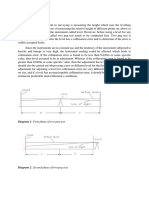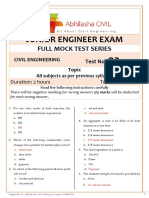Module 4
Leveling Methods
Differential Leveling
• Differential leveling is the process of determining the difference
in elevation between two or more points some distance apart.
• It requires a series of set ups of the instrument along a general
route and for each set up, a rod reading back to the point of
known elevation and forward to a point of unknown elevation
are taken.
Definition of Terms
• Bench Mark (BM) – A bench mark is a fixed point of reference whose
elevation is either known or assumed. They may be permanent or temporary.
• Backsight (BS) – A backsight is a reading taken on a rod held on a point of
known or assumed elevation. Backsights are frequently referred to as plus
sights (+S) since they are added to the elevation of points being sighted to
determine the height of instrument
• Foresight (FS) – A foresight is a reading taken on a rod on a point whose
elevation is to be determined. It is usually referred to as a minus sight (-S).
• Backsight Distance (BSD) – The backsight distance is measured from the
center of the instrument to the rod on which a backsight is taken.
• Foresight Distance (FSD) – the foresight distance is the horizontal distance
from the center of the instrument to the rod on which a foresight is taken.
• Turning Point (TP) – A turning point is an intervening point between two
bench marks, upon which point foresight and backsight rod readings are taken
to enable a leveling operation to continue from a new instrument position.
• Height of Instrument (HI) – The height of instrument (or height of collimation)
is the elevation of the line of sight of an instrument above or below a selected
reference datum.
Typical Differential Leveling Notes
Problem 1. Complete the differential level notes
shown and perform the customary arithmetic check.
Station BS HI FS Elevation
1.256 127.133
1.116 1.886
1.228 1.527
1.189 2.246
1.070 2.017
1.831 2.656
2.765
Double-Rodded
Differential Leveling
• Double-rodded differential leveling is a method of determining
differences in elevation between points by employing two level
routes simultaneously.
• This method differs from conventional differential leveling in
that two turning points are established such that at each setup
of the leveling instrument, two sets of independent backsights
and foresights are taken.
Three-Wire
Differential Leveling
• A more precise method of differential leveling can be attained by
the three-wire method of leveling.
• It is a method of determining differences in elevation wherein
three horizontal hairs (or threads) are read and recorded rather
than from a single horizontal hair.
Problem 1. The figure shows a schematic arrangement of a differential level
route employing two rods. The values indicated represent bakcsight and
foresight readings taken on two sets of turning points. Prepare and
complete differential level notes for the information shown and perform
the customary arithmetic check.
Problem 2. Complete the differential level notes shown below and perform the customary arithmetic check.
Profile Leveling
• The process of determining difference in elevation along a fixed
line at designated short measured intervals is referred to as
profile leveling.
• A profile is necessary for the design and construction of roads,
railroads, canals, culverts, bridges, sewer lines, and etc.
• In differential leveling, only one foresight is necessary whereas
in profile leveling, any number of foresights can be taken
Definition of Terms
• Profile – The profile is a curved line which graphically portrays the
intersection of a vertical plane with the surface of the earth.
• Stationing – A numerical designation given in terms of horizontal distance
any point along a profile line is away from the starting point.
• Intermediate Foresights – These sights, which are also known as ground rod
readings, are taken along the centerline of the proposed project to provide
an accurate representation of the ground surface.
• Full Stations – Full stations are points which are established along the profile
level route at uniformly measured distances.
• Plus stations – Plus station is any other intermediate point established along
a profile level route which is not designated as a full station.
• Vertical Exaggeration – It is a process of drawing the vertical scale for a
profile much larger than the horizontal scale in order to accentuate the
differences in elevation.
• Profile Paper – A special heavy grade graphing paper used for plotting
profiles.
Stationing
• Before levels are taken, the line along which the profile is required
must be properly marked by stakes on the ground.
• Stationings are used to indicate the distance of any ground stake from
the beginning point of the level route. It is carried continuously along
the route.
• A station and a plus is adapted to mark each stake.
Example: Full Station 100, 200, 400, 1300 meters
1+00, 2+00, 4+00, 13+00
Profile Level Notes
Plotted Profile for a Road Sample
Problem 1. Work out the following problems regarding points and stations along a profile level route.
a. A turning point along a profile level route measures 126. 44 m beyond station 8 + 24.50. Determine the
stationing of this turning point.
b. For the illustrated problem given above, determine the stationing of the turning point if it is instead
located 83.45 m before the given reference station.
c. Determine the distance between station 33 + 45.02 m and station 26 + 62.75 m.
Problem 2. Compute the following s et of profile level notes and show the customary arithmetic check.
Rise and Fall
Method of Leveling
• Another method of carrying out a leveling operation is by the rise and
fall method which is popularly adapted by the British.
• It is a very simple method and may serve as an alternate method for
profile or differential leveling or it may also be used to check a
completed set of level notes.
• In this method, the actual height of the instrument has no real
significance other than being the line to which vertical distances are
conveniently measured from various points on the ground.
Leveling Notes for Rise and Fall Method
Problem 1. Complete the method of rise and fall level notes as shown and show the customary arithmetic check.
Reciprocal Leveling
• Reciprocal leveling is employed to determine the difference in
elevation between two points when it is difficult or impossible to
keep backsights and foresights short and equal.
• The procedure followed is known as the method of reversion,
just as employed in the two-peg test.
Trigonometric Leveling
• Trigonometric leveling or indirect leveling is defined as
the determination of the differences in elevation from
observed vertical angles and either horizontal or
inclined distances.
• For much longer sights, the effect of the earth’s
curvature and refraction is considered. For upward
sight or positive vertical angle, the combined
correction due to the effect of curvature and
refraction is added; for downward sight or negative
vertical angle, it is subtracted.
Problem 1. In leveling across a wide river,
reciprocal level readings were taken between two
points A and B as shown in the accompanying
tabulation. Determine the following:
a. Difference in elevation.
b. Elevation of B if the elevation of A is 951.750m.
Instrument Set-up Near A Instrument Set-up Near B
STA BS FS STA BS FS
1.283 1.478
1.284 1.480
a b’
1.286 1.476
1.283 1.478
0.675 2.143
0.674 2.140
0.677 2.145
b a’
0.674 2.142
0.677 2.143
0.678 2.146
SUM SUM
MEAN MEAN
Problem 2. Let A be a point of elevation
130.49 m, above datum, and let B and C be
points of unknown elevation. By means of
instrument set 1.22 m above B, vertical
angles observed, that to A being -14°45’
and that to C being +8°32’. If the horizontal
distance between AB is 547.20 m and the
horizontal distance BC is 923.95 m,
determine the elevation of B and C,
making due allowance for earth’s
curvature and refraction.






